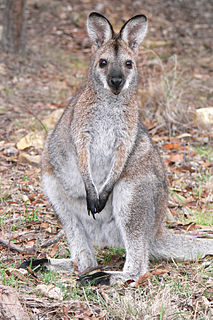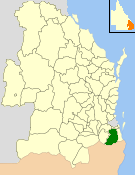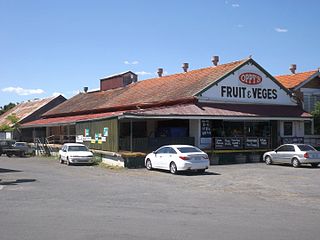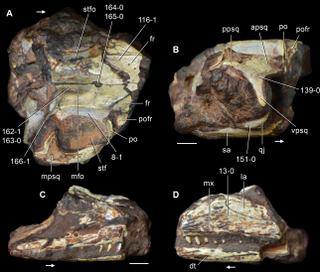Related Research Articles

Macropodidae is a family of marsupials that includes kangaroos, wallabies, tree-kangaroos, wallaroos, pademelons, quokkas, and several other groups. These genera are allied to the suborder Macropodiformes, containing other macropods, and are native to the Australian continent, New Guinea and nearby islands.

The term Australian megafauna refers to the megafauna in Australia during the Pleistocene Epoch. Most of these species became extinct during the latter half of the Pleistocene, and the roles of human and climatic factors in their extinction are contested.

Muttaburrasaurus was a genus of herbivorous iguanodontian ornithopod dinosaur, which lived in what is now northeastern Australia sometime between 110 and 103 million years ago during the early Cretaceous period. It has been recovered in some analyses as a member of the iguanodontian clade Rhabdodontomorpha. After Kunbarrasaurus, it is Australia's most completely known dinosaur from skeletal remains. It was named after Muttaburra, the site in Queensland, Australia, where it was found.

Minmi is a genus of small herbivorous ankylosaurian dinosaur that lived during the early Cretaceous Period of Australia, about 133 to 120 million years ago.
Rhoetosaurus, named after Rhoetus, a titan in Greek Mythology, is a genus of sauropod dinosaur from the Jurassic (Oxfordian) Walloon Coal Measures of what is now eastern Australia. Rhoetosaurus is estimated to have been about 15 metres (49 ft) long, weighing about 9 tonnes. Subsequent authors have sometimes misspelled the name: Rhaetosaurus ; Rheteosaurus.

Palorchestes is an extinct genus of terrestrial, herbivorous marsupials of the family Palorchestidae. The genus was endemic to Australia, living from the Miocene through to the Pleistocene epochs.

Sthenurus is an extinct genus of kangaroos. With a length around 3 m (10 ft), some species were twice as large as modern extant species. Sthenurus was related to the better-known Procoptodon. The subfamily Sthenurinae is believed to have separated from its sister taxon, the Macropodinae, halfway through the Miocene, and then its population grew during the Pliocene.
Ralph E. Molnar is a paleontologist who had been Curator of Mammals at the Queensland Museum and more recently associated with the Museum of Northern Arizona. He is also a research associate at the Texas natural Science Centre. He co-authored descriptions of the dinosaurs Muttaburrasaurus, Kakuru, Minmi and Ozraptor, as well as the mammal Steropodon.

The Shire of Boonah was a local government area in South East Queensland, Australia, about 80 kilometres (50 mi) southwest of Brisbane. The shire covered an area of 1,921.6 square kilometres (741.9 sq mi), and existed from 1880 until its merger with parts of the Shire of Beaudesert and City of Ipswich to form the Scenic Rim Region on 15 March 2008.

The Shire of Beaudesert was a local government area located in South East Queensland, Australia, stretching from the New South Wales border, along the Gold Coast hinterland to the urban fringes of the cities of Brisbane and Ipswich. The Shire covered an area of 2,854.3 square kilometres (1,102.1 sq mi), and existed from 1879 until its abolition on 15 March 2008, following which it was split between Logan City and the new Scenic Rim Region.
Mary Julia Wade was an Australian palaeontologist, known for her role as the Deputy Director of the Queensland Museum. Some of her most renowned work was on the Precambrian Ediacaran Biota in South Australia.
The Toolebuc Formation is a geological formation that extends from Queensland across South Australia and the Northern Territory in Australia, whose strata date back to the Albian stage of the Early Cretaceous. Dinosaurs, pterosaurs, plesiosaurs, ichthyosaurs, protostegid turtles, sharks, chimaeroids and bony fish remains are among the fossils that have been recovered from the formation.
The Allaru Formation, also known as the Allaru Mudstone, is a geological formation in Queensland, Australia, whose strata date back to the Early Cretaceous. Dinosaur remains are among the fossils that have been recovered from the formation.

Kalbar is a rural town and locality in the Scenic Rim Region, Queensland, Australia. In the 2016 census, the locality of Kalbar had a population of 1,093 people.

Prolacertidae is an extinct family of archosauromorph reptiles that lived during the Early Triassic epoch. It was named in 1935 by the British palaeontologist Francis Rex Parrington to include the species Prolacerta broomi of South Africa and Antarctica. In 1979 a second species, Kadimakara australiensis, was described from Australia. Several other genera, such as Macrocnemus, Pamelaria and Prolacertoides, have also been assigned to this family in the past, but these have been placed elsewhere by later studies, leaving Prolacerta and Kadimakara as the only well-supported members.

Fossil Cave (5L81), formerly known as The Green Waterhole, is a cave in the Limestone Coast region of south-eastern South Australia. It is located in the gazetted locality of Tantanoola about 22 kilometres north-west of the city of Mount Gambier, only a few metres from the Princes Highway between Mount Gambier and Millicent. It is popular with cave divers and is notable for being both a unique paleontological site and the "type locality" for very rare crustaceans which to date have been found only in caves and Blue Lake in the Mount Gambier region.
Kenton Stewart Wall Campbell, known as Ken Campbell, was an Australian palaeontologist and academic. Campbell was born in Ipswich, Queensland. He was the son of two store clerks who moved their family to Boonah during the Great Depression. He attended primary school in Ipswich, Boonah and Coorparoo. After winning a scholarship to attend Brisbane Grammar School in 1940, Campbell went on to university. In 1945, Campbell entered his second year of his study, attending lectures given by Dr Dorothy Hill, who had returned from World War II service in the WRANS. Her academic rigour inspired him. He took his B.Sc. with Honours from the University of Queensland in 1949 on her advice, followed by his M.Sc. in 1951 and PhD in 1958. His research was in Permian brachiopods of the Bowen and adjacent basins.

The Boonah Butter Factory is a heritage-listed former butter factory in Boonah, Scenic Rim Region, Queensland, Australia. Constructed in 1916, it is a prominent landmark at the intersection of Boonah-Rathdowney Road and Railway Street on the northern entry to Boonah. During the first part of the twentieth century, it was one of the most modern butter factories in the Commonwealth, the largest butter factory in the Southern Hemisphere, had the second highest output of butter in Queensland and was a major supplier of dairy products to Brisbane. The former Boonah Butter Factory office, which is currently the premises of Flavours Cafe, is on the Local Heritage Register of the Scenic Rim Regional Council in acknowledgement of the site's historic, aesthetic and cultural significance.

Kadimakara is an extinct genus of early archosauromorph reptile from the Arcadia Formation of Queensland, Australia. It was seemingly a very close relative of Prolacerta, a carnivorous reptile which possessed a moderately long neck. The generic name Kadimakara references prehistoric creatures from Aboriginal myths which may have been inspired by ice-age megafauna. The specific name K. australiensis relates to the fact that it was found in Australia. Prolacerta and Kadimakara were closely related to the Archosauriformes, a successful group which includes archosaurs such as crocodilians, pterosaurs, and dinosaurs.
Ipswich–Boonah–Rathdowney Road is a continuous 87.8 kilometres (54.6 mi) road route in the Ipswich and Scenic Rim regions of Queensland, Australia. It has two official names, Ipswich–Boonah Road and Boonah–Rathdowney Road. The entire route is signed as State Route 93, and much of it is also part of Tourist Drive 16.
References
- 1 2 3 4 Mather, Patricia (1986). A time for a museum: the history of the Queensland Museum 1862-1986. Queensland Museum. p. 143. ISBN 0724216456.
- 1 2 3 4 5 6 7 8 9 10 11 12 13 14 Rozefelds, Andrew (2017). "In memoriam Alan Bartholomai (1938 - 2015)". Memoirs of the Queensland Museum. 60: 119–131.
- ↑ "591 IPSWICH AND DISTRICT STATE SCHOLARSHIP PASSES". Queensland Times (Ipswich, Qld. : 1909 - 1954). 15 January 1953. p. 3. Retrieved 21 March 2019.
- ↑ "They' ve found an ichthyosaur in Queensland". Australian Women's Weekly (1933 - 1982). 20 June 1979. p. 22. Retrieved 21 March 2019.
- ↑ "Minmi Crossing memoirs" (PDF). Retrieved 21 March 2019.
- ↑ "Australian Age of Dinosaurs | Muttaburrasaurus langdoni". www.australianageofdinosaurs.com. Retrieved 21 March 2019.
- ↑ "PNG artifacts will return to us as gifts". Papua New Guinea Post-Courier (Port Moresby : 1969 - 1981). 4 October 1974. p. 15. Retrieved 21 March 2019.
- ↑ "THE AUSTRALIA DAY 2012 HONOURS". Commonwealth of Australia Gazette. Special (National : 1977 - 2012). 26 January 2012. p. 1. Retrieved 21 March 2019.
- ↑ "THE COURIER-MAIL TRIBUTES". tributes.couriermail.com.au. Retrieved 21 March 2019.